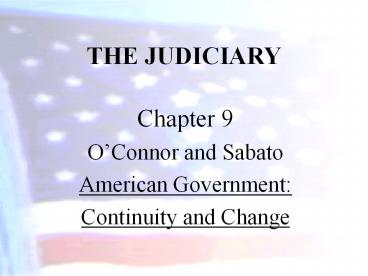THE JUDICIARY - PowerPoint PPT Presentation
Title:
THE JUDICIARY
Description:
THE JUDICIARY Chapter 9 O Connor and Sabato American Government: Continuity and Change – PowerPoint PPT presentation
Number of Views:118
Avg rating:3.0/5.0
Title: THE JUDICIARY
1
THE JUDICIARY
- Chapter 9
- OConnor and Sabato
- American Government
- Continuity and Change
2
THE JUDICIARY
- In this chapter we will cover
- The Constitution and the National Judiciary
- The American Legal System
- The Federal Court System
- How Federal Court Judges are Selected
- The Supreme Court Today
- How the Justices Vote
- Judicial Policy Making and Implementation
3
THE JUDICIARY
- Alexander Hamilton penned in the Federalist 78
that the judiciary would be the least dangerous
branch of government. It lacked the teeth of both
the other branches of government it had neither
the power of the sword nor the power of the
purse. - Today the federal courts are very powerful.
- Nevertheless, the courts still have two basic
limitations they have neither the power of the
purse, nor the of the sword. - The court cannot fund programs or their
implementation nor can it force compliance with
its rulings.
4
The Constitution and the National Judiciary
- Article III of the Constitution establishes
- a Supreme Court in which the judicial power of
the United States is vested - life tenure or 'good behaviour' for judges
- judges receive compensation that cannot be
diminished during their service - such inferior courts as Congress may choose to
establish - the original jurisdiction of the Supreme Court
- The intent of Article III was to remedy the
failings of the Articles of Confederation which
left judicial matters to the states.
5
Judicial Review
- Judicial review is the power of a court to decide
if a law or other legal issue contravenes the
Constitution, and overturn it. - This power is not mentioned in the Constitution.
- Judicial review was established by the Marshall
Court for itself and posterity in Marbury v.
Madison (1803). - Marbury's long-term effect has been to allow the
Court to have the final say in what the
Constitution means.
6
Judicial Review
- Judges have used this power sparingly.
- The power has only been used about 140 times to
strike down acts of Congress. - Although more frequently (over 1200 times) to
invalidate acts of state legislatures.
7
The American Legal System
- The American legal system is a dual system
- state courts--actually 50 different 'systems'
- federal courts
- Both systems have three tiers
- trial courts--litigation begins and courts hear
the facts of the case at hand (original
jurisdiction) - appellate courts--decide questions of law, not
fact (appellate jurisdiction) - high or supreme courts
8
(No Transcript)
9
(No Transcript)
10
Federal Selection Process
- The selection of judges is a very political
process. - Judges are nominated by the president and
confirmed by the Senate. - Often presidents solicit suggestions from members
of the House of Representatives, Senators, their
political party, and others. - Provides president opportunity to put
philosophical stamp on federal courts
11
Who are Federal Judges?
- Typically federal judges have
- held previous political office such as prosecutor
or state court judge - political experience such as running a campaign
- prior judicial experience
- traditionally been mostly white males
- been lawyers
12
Federal Selection Process
President
Dept. of Justice
Senators
ABA
Interest Groups
Senate Jud. Comm.
Senate
13
Nomination Criteria
- No constitutional qualifications
- Competence
- Ideology/Policy Preferences
- Rewards
- Pursuit of Political Support
- Religion
- Race and gender
14
(No Transcript)
15
(No Transcript)
16
How the Justices Vote
- Legal Factors
- Judicial Philosophy
- Judicial Restraint - advocates minimalist roles
for judges, and the latter - Judicial Activism - feels that judges should use
the law to promote justice, equality, and
personal liberty. - Precedent
- Prior judicial decisions serve as a rule for
settling subsequent cases of a similar nature.
17
How the Justices Vote
- Extra-Legal Factors
- Behavioral Characteristics
- The personal experiences of the justices affect
how they vote. Early poverty, job experience,
friends and relatives all affect how decisions
are made. - Ideology
- Ideological beliefs influence justices' voting
patterns. - The Attitudinal Model
- A justice's attitudes affect voting behavior.
- Public Opinion
- Justices watch TV, read newspapers, and go to the
store like everyone else. They are not insulated
from public opinion and are probably swayed by it
some of the time.
18
(No Transcript)
19
How Supreme Court Decisions are Made
Case on the Docket Approx 95
Briefs and Amicus Briefs submitted
Oral Argument
Justices Conference Cases discussed Votes
taken Opinion Assigned
Opinions Announced
Opinions Drafted and Circulated
20
Judicial Policy Making and Implementation
- All judges make policy.
- This was particularly noticeable following the
Court ordered desegregation in 1954 Brown ruling.
- Courts do not have the power to implement their
decisions. The executive branch must enforce the
Courts decisions.
21
(No Transcript)
22
The Supreme Court Today
- According to a 1990 poll, only 23 of Americans
knew how many justices sit on the Supreme Court,
and two-thirds could not name a single member. - In 1998, a poll of teenagers showed that only 2
could name the Chief Justice. - The Supreme Court, and the federal court system,
have a number of powers and some significant
limitations. - The courts are peopled by individuals like all of
us who are influenced by participation in society.































